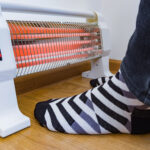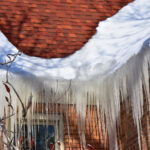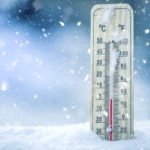Previously, on EATOTT…
[In this blog series, we’ll cover a new tool each month and break down how we use it and what it can tell us about your home’s energy efficiency… Meet Fen and Fin, the blower door fans… In a matter of minutes, Fen and Fin reveal all the cracks in a home while providing one of the best data points for your home’s energy efficiency… Curious how it’s done? Learn more here!]

Blower door fans may be the largest piece of equipment we bring into your home, but the manometer is the real brains of the operation. This small device, slightly bigger than a scientific calculator, is our draft detector, pressure sensor, and fan flow meter all rolled into one. When anything needs measuring, the manometer is the energy auditor’s ultimate tool of the trade.
In this blog, we’ll be following Muppet and Manny throughout the tasks they complete throughout an energy audit and at a job.

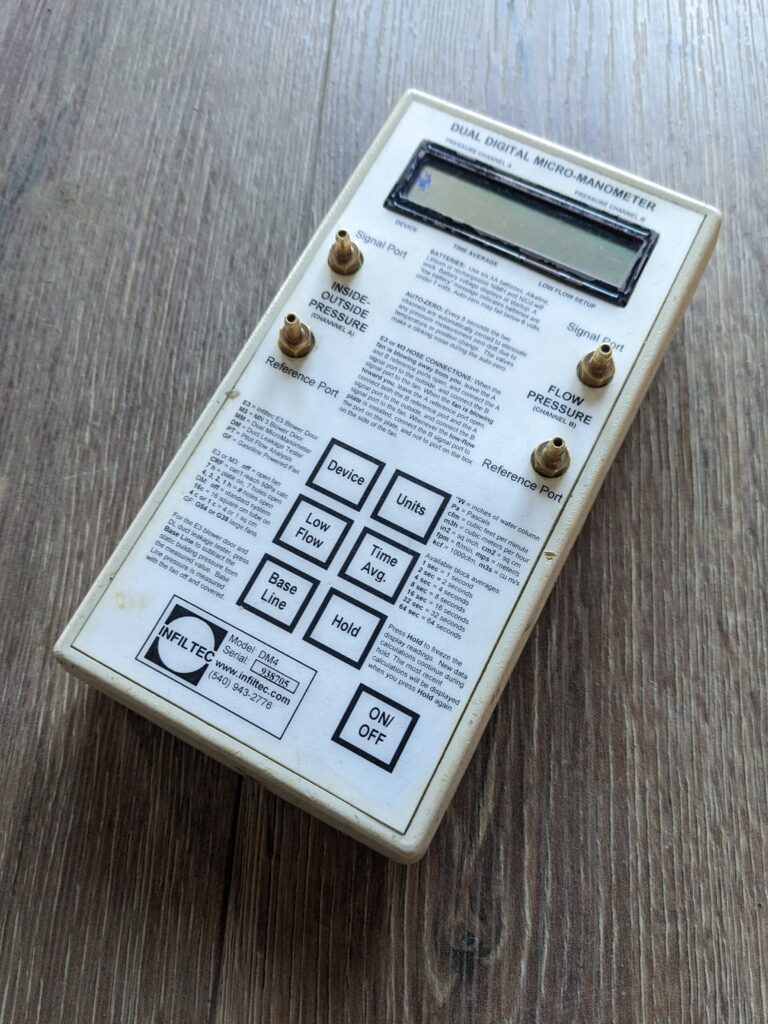
Blown Away
The first time auditors use the manometer is when setting up the blower door test. Once the frame is in place, the manometer is connected to the fan through a tube. Another tube, known as the inside-outside pressure hose, feeds through the frame from the outside to also provide a reading. When the fan is turned on, the manometer informs auditors how much cubic feet of air per minute (cfms) is traveling out of the house at a pressure of 50 pascals.
With this data we can calculate your home’s ACH50, or Air Changes per Hour at 50 pascals. This tells us how many times in an hour your home is replacing all of its air. Most new builds should be around 3-5 ACH50, whereas the goal for older houses is to reduce the ACH50 to 6-12. Auditors typically see a range of 7-25, but most homes tend to fall around 16 ACH50 before airsealing work is performed.


Feelin’ the Pressure
While the blower door is running, auditors use the pressure pan to test common draft points. By connecting the manometer to the pressure pan, it can measure the cfms entering your home through light switches, outlets, and recessed lights. We also use it to measure any leaks in your ventilation system.
During the audit, it may seem as if auditors are speaking to each other in numbers. However, these numbers are fairly easy to understand. Below I’ve included a chart for speedy interpretation. At the end of the day, the closer the reading is to 0, the tighter your house is, but if you’re ever in doubt, ask your auditors!
What We Measure | Reading Range (cfms) | Interpretations |
Light switches / Outlets / Recessed Lights / Other openings | a.) 0-25 |
|
b.) 25-50 |
| |
HVAC Vents | a.) 0-3 | a.) Ducts are tight |
b.) 3-5 | b.) Moderate leakage | |
c.) 5+ | c.) Loose ducts |
(Note: These readings are all gathered while the blower door fan is running at a pressure of 50 pascals, your home is not leaking this much in its natural state.)
For more details on the pressure pan, stay tuned for next month’s EATOTT!
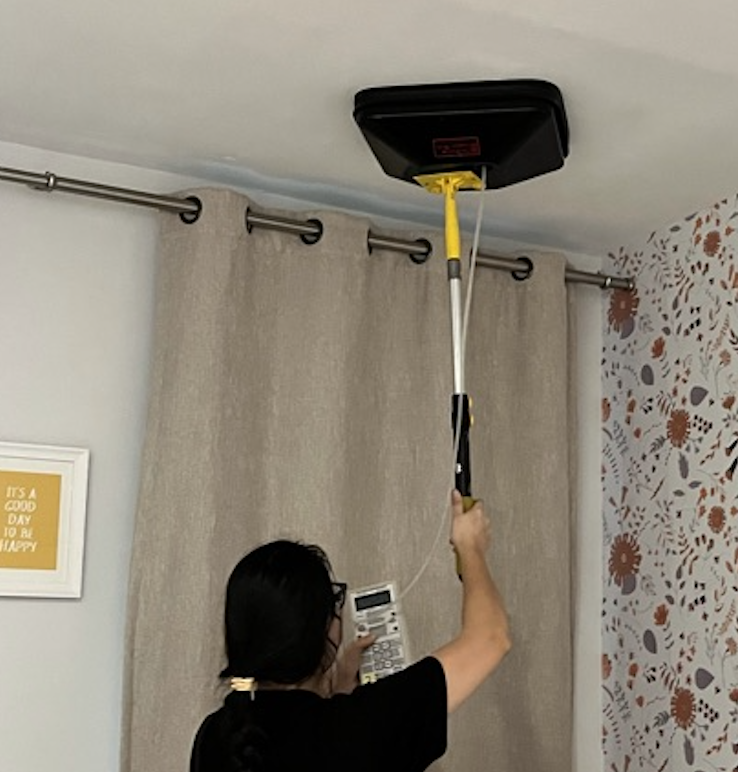
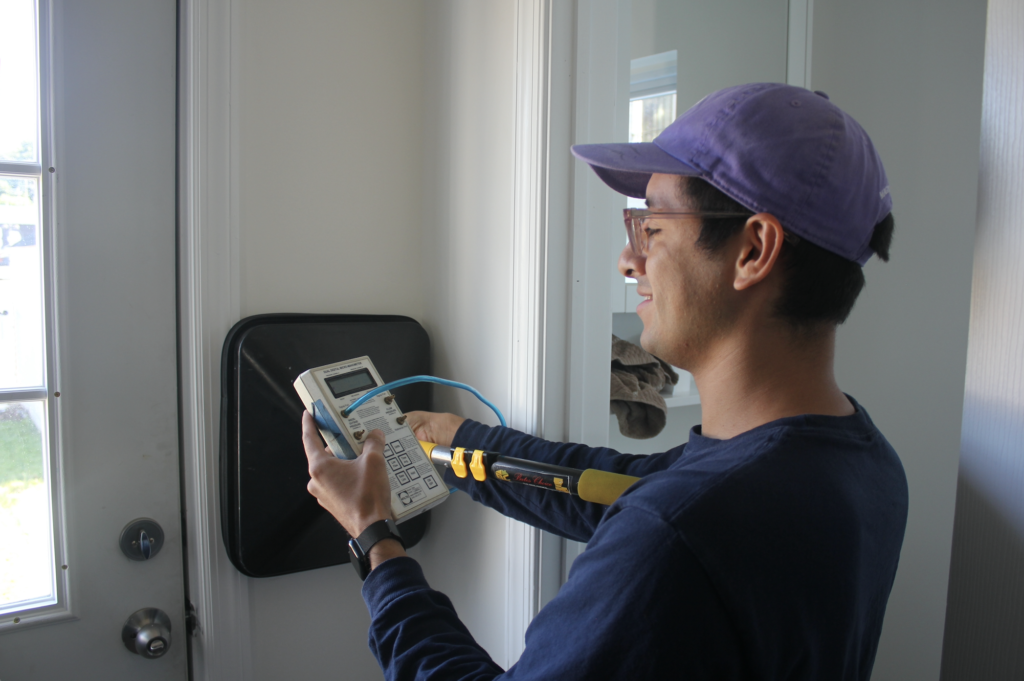
An Exhaust-ive Review
Auditors also use the manometer when measuring bathroom fans. By adjusting the opening on an exhaust pan, the manometer provides an accurate measure on the strength of your exhaust fans. We see readings ranging from 0-100 cfms and beyond, but most fans typically fall within 15-50 cfms. A good rule of thumb is listening to the fan – contrary to what one might expect, the louder the fan, the less it exhausts.
EmPOWER Maryland follows the ventilation requirements of the American Society of Heating, Refrigerating, and Air- Conditioning Engineers, also known as ASHRAE. We apply these same requirements to your exhaust fans and consider 50 cfms as the minimum measurement. Note: According to ASHRAE, having an operable window increases your overall ventilation potential by 20 cfms!
In some cases, we measure bathroom fans with a pressure pan while the blower door is running; however this is not to measure your bathroom fan cfms. Instead we’re measuring how much air from your attic is making its way into your house through your bathroom fan. When your bathroom fans aren’t vented out properly, it can be like having an open window year-round!


Just BeCAZ
The most important data the manometer measures in terms of safety is the CAZ test. CAZ stands for Combustion Appliance Zone, and refers to the area in your home with combustion appliances like gas water heaters and gas furnaces/boilers. By conducting a CAZ test, we are able to see how much potential your CAZ has for spilling combustible gases into your home.
We measure this by gathering a baseline pressure measurement for your home in natural conditions, where all interior doors are open, exhaust fans are off, the HVAC is off, and the water heater is on pilot. Then we measure again in worst case conditions, where interior doors are closed and exhaust fans are on. This is the most important number to gather, as it shows us how well your CAZ appliances are able to move combustible gases out of the house when everything in the house is trying to pull it to the interior. For example, if every bathroom fan was on for showers, the dryer was on drying clothes, and someone was using the kitchen hood while cooking- do your combustion appliances still draft out of the home, or do some gases make their way inside?

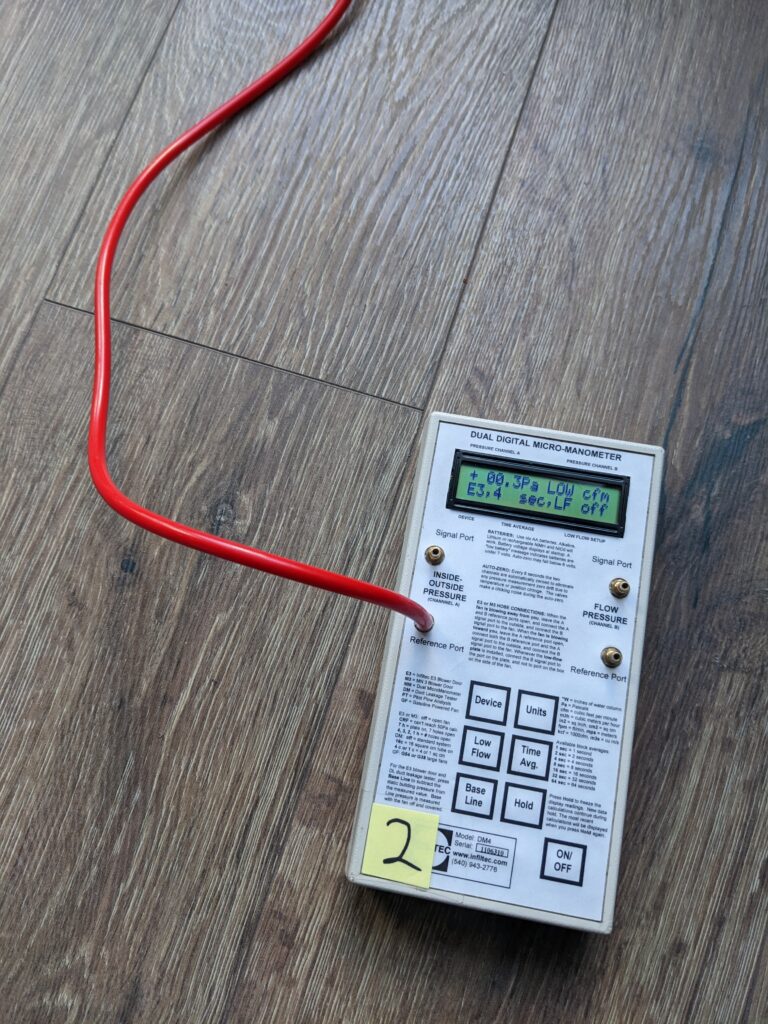
On the Job
Manometers aren’t just useful during an audit, we also use them on the job. Before any of the work is started, our crew sets up a blower door to get a new number. After the work is completed, another blower door number is measured to see how well our efforts at tightening the home succeeded, and also ensure we didn’t over-seal. If any fans were installed during a job the crew will also measure how many cfms the fan is exhausting. Note: We install 150 cfm fans but after venting them out, they will be at a lower cfm. Finally, and most importantly, another CAZ test is completed to ensure your gas furnace/boiler/water heater is still able to draft combustible gases out of your home.
The manometer is both useful and versatile, providing the majority of readings we gather throughout an audit and on the job. It’s amazing to think such a small device can be so helpful, but its ability to provide data from blower doors to draft points to CAZ and beyond makes the manometer the Ultimate Energy Auditors’ Tool of the Trade.
Ready to see Muppet or Manny in action? Schedule a home energy audit today!
How can we help?
At Energy Efficiency Experts we inspect the structural integrity of your home and look for possible cracks and holes in what we call the “conditioned envelope”, or the shell of your home which contains all your conditioned air. Using the manometer, we collect a variety of data points to evaluate your home’s energy efficiency, from draftiness to the strength of your bathroom fans. We service homes from Washington DC to Silver Spring and beyond. If you live in the Washington DC/Maryland/Virginia (DMV) area and are curious about how your home measures up, schedule a home energy audit at https://energyefficiencyexperts.com/contact/ or call our office at 202-557-9200.
Curious about what other services we provide? Check out the full list of auditing services and see what our in-house crew can do for you!





















